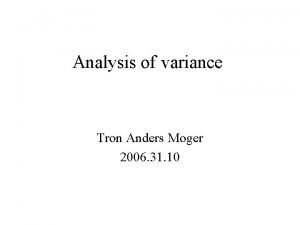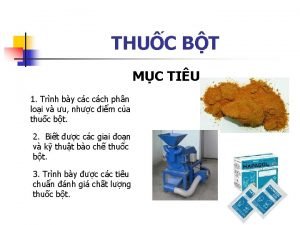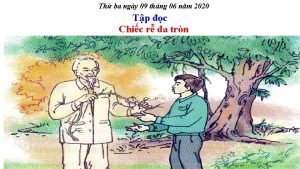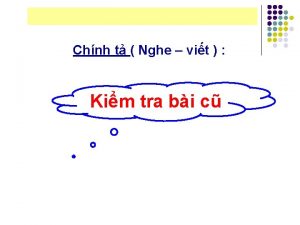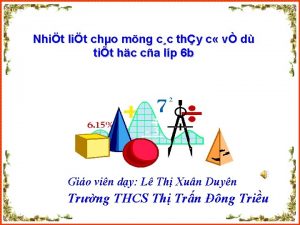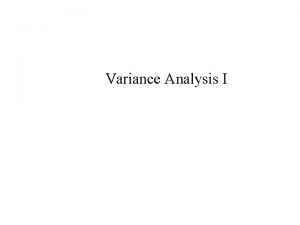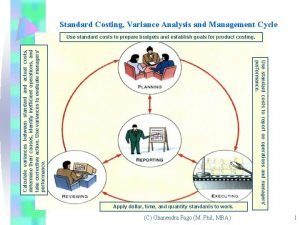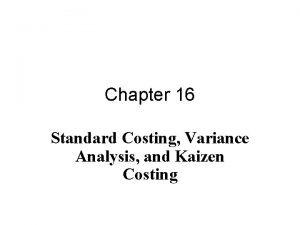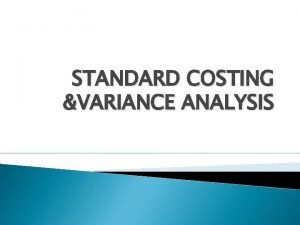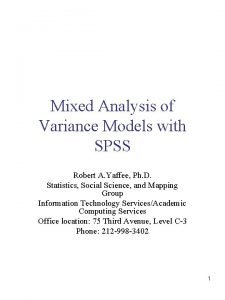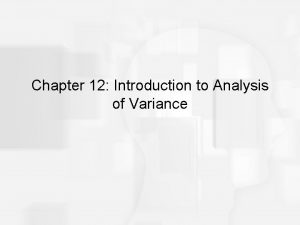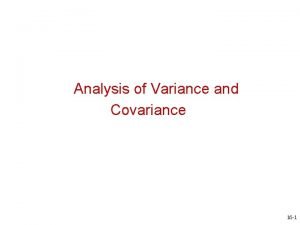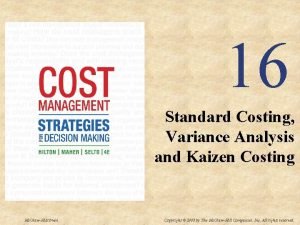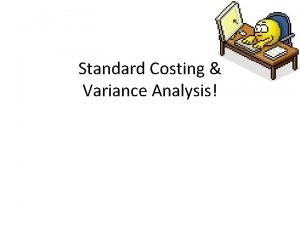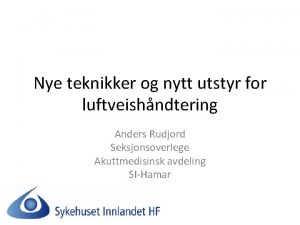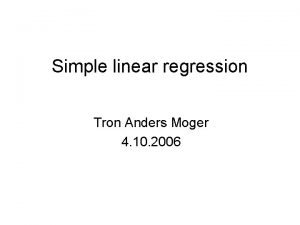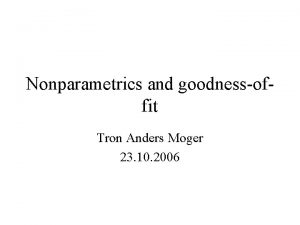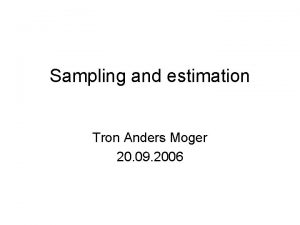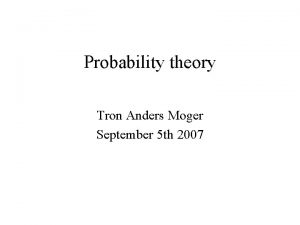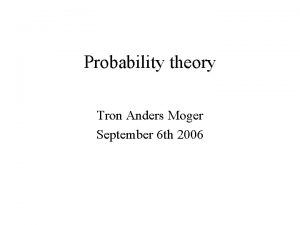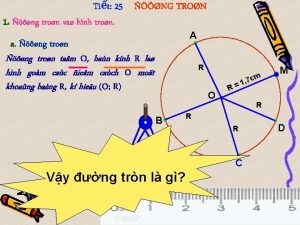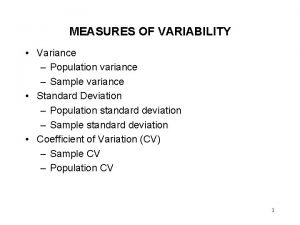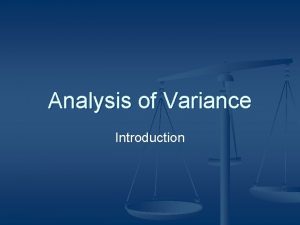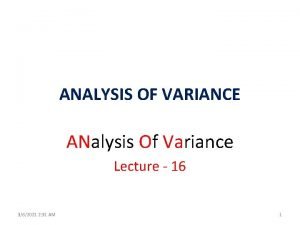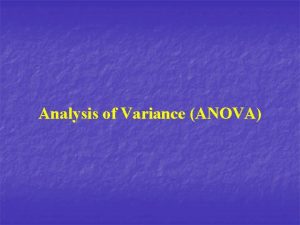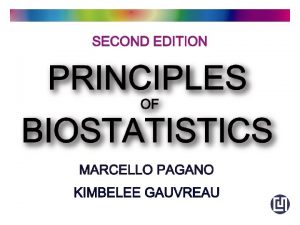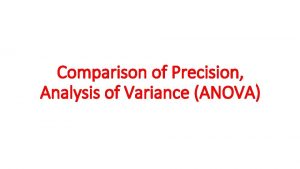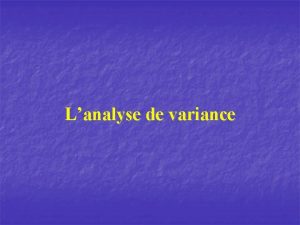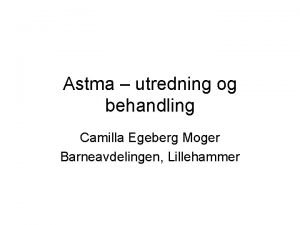Analysis of variance Tron Anders Moger 2006 31






































- Slides: 38

Analysis of variance Tron Anders Moger 2006. 31. 10

Comparing more than two groups • Up to now we have studied situations with – One observation per object • One group • Two groups – Two or more observations per object • We will now study situations with one observation per object, and three or more groups of objects • The most important question is as usual: Do the numbers in the groups come from the same population, or from different populations?

ANOVA • If you have three groups, could plausibly do pairwise comparisons. But if you have 10 groups? Too many pairwise comparisons: You would get too many false positives! • You would really like to compare a null hypothesis of all equal, against some difference • ANOVA: ANalysis Of VAriance

One-way ANOVA: Example • Assume ”treatment results” from 13 patients visiting one of three doctors are given: – Doctor A: 24, 26, 31, 27 – Doctor B: 29, 31, 30, 36, 33 – Doctor C: 29, 27, 34, 26 • H 0: The means are equal for all groups (The treatment results are from the same population of results) • H 1: The means are different for at least two groups (They are from different populations)

Comparing the groups • Averages within groups: – Doctor A: 27 – Doctor B: 31. 8 – Doctor C: 29 • Total average: • Variance around the mean matters for comparison. • We must compare the variance within the groups to the variance between the group means.

Variance within and between groups • Sum of squares within groups: • Compare it with sum of squares between groups: • Comparing these, we also need to take into account the number of observations and sizes of groups

Adjusting for group sizes • Divide by the number of degrees of freedom Both are estimates of population variance of error under H 0 n: number of observations K: number of groups • Test statistic: reject H 0 if this is large

Test statistic thresholds • If populations are normal, with the same variance, then we can show that under the null hypothesis, MSG and MSW are Chisquare distributed with K-1 and n-K d. f. The F distribution, with K-1 and n-K degrees of freedom • Reject at confidence level if Find this value in table p. 871

Continuing example • Thus we can NOT reject the null hypothesis in our case.

ANOVA table Source of variation Sum of squares Deg. of freedom Mean squares Between groups SSG K-1 MSG Within groups SSW n-K MSW Total SST n-1 NOTE: F ratio

Formulation of the model: • H 0: µ 1=µ 2=…=µK • Xij=µi+εij • Let Gi be the difference between the group means and the population mean. Then: • Gi=µi-µ of µi=µ+Gi • Giving Xij=µ+Gi+εij • And H 0: G 1=G 2=…=GK=0

One-way ANOVA in SPSS • Last column: The p-value: The smallest value of at which the null hypothesis is rejected.

One-way ANOVA in SPSS: • Analyze - Compare Means - One-way ANOVA • Move dependent variable to Dependent list and group to Factor • Choose Bonferroni in the Post Hoc window to get comparisons of all groups • Choose Descriptive and Homogeneity of variance test in the Options window

Energy expenditure example: • Let us say we have measurements of energy expenditure in three independent groups: Anorectic, lean and obese • Want to test H 0: Energy expenditure is the same for anorectic, lean and obese • Data for anorctic: 5. 40, 6. 23, 5. 34, 5. 76, 5. 99, 6. 55, 6. 33, 6. 21

SPSS output: • See that there is a difference between groups. • See also between which groups the difference is!

Conclusion: • There is a significant overall difference in energy expenditure between the three groups (p-value<0. 001) • There also significant differences for all two-by-two comparisons of groups

The Kruskal-Wallis test • ANOVA is based on the assumption of normality • There is a non-parametric alternative not relying this assumption: – Looking at all observations together, rank them – Let R 1, R 2, …, RK be the sums of ranks of each group – If some R’s are much larger than others, it indicates the numbers in different groups come from different populations

The Kruskal-Wallis test • The test statistic is • Under the null hypothesis, this has an approximate distribution. • The approximation is OK when each group contains at least 5 observations.

Example: previous data Doctor A Doctor B Doctor C 24 (rank 1) 29 (rank 6. 5) 26 (rank 2. 5) 31 (rank 9. 5) 27 (rank 4. 5) 31 (rank 9. 5) 30 (rank 8) 34 (rank 12) 27 (rank 4. 5) 36 (rank 13) 26 (rank 2. 5) 33 (rank 11) R 1=17. 5 R 2=48 R 3=25. 5 (We really have too few observations for this test!)

Kruskal-Wallis in SPSS • Use ”Analyze=>Nonparametric tests=>K independent samples” • For our data, we get

For the energy data: • Same result as for one-way ANOVA! • Reject H 0

When to use what method • In situations where we have one observation per object, and want to compare two or more groups: – Use non-parametric tests if you have enough data • For two groups: Mann-Whitney U-test (Wilcoxon rank sum) • For three or more groups use Kruskal-Wallis – If data analysis indicate assumption of normally distributed independent errors is OK • For two groups use t-test (equal or unequal variances assumed) • For three or more groups use ANOVA

When to use what method • When you in addition to the main observation have some observations that can be used to pair or block objects, and want to compare groups, and assumption of normally distributed independent errors is OK: – For two groups, use paired-data t-test – For three or more groups, we can use two-way ANOVA

Two-way ANOVA (without interaction) • In two-way ANOVA, data fall into categories in two different ways: Each observation can be placed in a table. • Example: Both doctor and type of treatment should influence outcome. • Sometimes we are interested in studying both categories, sometimes the second category is used only to reduce unexplained variance (like an independent variable in regression!). Then it is called a blocking variable • Compare means, just as before, but for different groups and blocks

Data from exercise 17. 46: • Three types of aptitude tests (K=3) given to prospective management trainers • Each test type is given to members of each of four groups of subjects (H=4): Profile fit, Mindbender, Psych Out Test type Subject type Profile fit Mindbender Psych Out Poor 65 69 75 Fair 74 72 70 Good 64 68 78 Excellent 83 78 76

Sums of squares for two-way ANOVA • Assume K groups, H blocks, and assume one observation xij for each group i and each block j, so we have n=KH observations (independent!). – Mean for category i: – Mean for block j: – Overall mean: • Model: Xij=µ+Gi+Bj+εij

Sums of squares for two-way ANOVA

ANOVA table for two-way data Source of variation Sums of squares Deg. of freedom Mean squares F ratio Between groups SSG K-1 MSG= SSG/(K-1) MSG/MSE Between blocks SSB H-1 MSB= SSB/(H-1) MSB/MSE Error SSE (K-1)(H-1) MSE= SSE/(K -1)(H-1) Total SST n-1 Test for between groups effect: compare to Test for between blocks effect: compare to

Two-way ANOVA (with interaction) • The setup above assumes that the blocking variable influences outcomes in the same way in all categories (and vice versa) • We can check if there is interaction between the blocking variable and the categories by extending the model with an interaction term • Need more observations per block • Other advantages: More precise estimates

Data from exercise 17. 46 cont’d: • Each type of test was given three times for each type of subject Test type Subject type Profile fit Mindbender Psych Out Poor 65 68 62 69 71 67 75 75 78 Fair 74 79 76 72 69 69 70 69 65 Good 64 72 65 68 73 75 78 82 80 Excellent 83 82 84 78 78 75 76 77 75

Sums of squares for two-way ANOVA (with interaction) • Assume K groups, H blocks, and assume L observations xij 1, xij 2, …, xij. L for each category i and each block j block, so we have n=KHL observations (independent!). – Mean for category i: – Mean for block j: – Mean for cell ij: – Overall mean: • Model: Xijl=µ+Gi+Bj+Iij+εijl

Sums of squares for two-way ANOVA (with interaction)

ANOVA table for two-way data (with interaction) Source of variation Sums of squares Deg. of freedom Mean squares F ratio Between groups SSG K-1 MSG= SSG/(K-1) MSG/MSE Between blocks SSB H-1 MSB= SSB/(H-1) MSB/MSE Interaction SSI (K-1)(H-1) MSI= SSI/(K-1)(H-1) MSI/MSE Error SSE KH(L-1) Total SST n-1 MSE= SSE/KH(L-1) Test for interaction: compare MSI/MSE with Test for block effect: compare MSB/MSE with Test for group effect: compare MSG/MSE with

Two-way ANOVA in SPSS • Analyze->General Linear Model-> Univariate • Move dependent variable (Score) to Dependent Variable • Move test type and subject type to Fixed Factor(s) • Under Options, may check Descriptive Statistics and Homogeneity Tests, and also get two-by-two comparisons by checking Bonferroni under Post Hoc • Gives you a full model (with interaction)

Some SPSS output: Equal variances can be assumed • See that there is a significant block effect, significant group effect, and a significant interaction effect • Means (in plain words) that test score is different for subject types, for the three tests, and that difference for test type depends on what block you consider

Two-by-two comparisons

Notes on ANOVA • All analysis of variance (ANOVA) methods are based on the assumptions of normally distributed and independent errors • The same problems can be described using the regression framework. We get exactly the same tests and results! • There are many extensions beyond those mentioned • In fact, the book only briefly touches this subject • More material is needed in order to do two-way ANOVA on your own

Next time: • • How to design a study? Different sampling methods Research designs Sample size considerations
 Tron anders moger
Tron anders moger Variance analysis meaning
Variance analysis meaning Vua nào xuống chiếu dời đô
Vua nào xuống chiếu dời đô Nguyên tắc trộn bột kép
Nguyên tắc trộn bột kép Tập đọc chiếc rễ đa tròn
Tập đọc chiếc rễ đa tròn đường dầu
đường dầu Cây rơm đã cao và tròn nóc
Cây rơm đã cao và tròn nóc để nguyên nước chấm cổ truyền
để nguyên nước chấm cổ truyền Oddajmy cześć wiecznemu panu chwał
Oddajmy cześć wiecznemu panu chwał Cây bò trên đất lá ráp quả tròn
Cây bò trên đất lá ráp quả tròn Nằm cuộn tròn trong chiếc chăn bông ấm áp
Nằm cuộn tròn trong chiếc chăn bông ấm áp Những chấm tròn thú vị
Những chấm tròn thú vị Jumo tron
Jumo tron Hình ảnh đường tròn trong thực tế
Hình ảnh đường tròn trong thực tế Trời mưa đường đất sét trơn như
Trời mưa đường đất sét trơn như Static budget variance example
Static budget variance example The variance analysis cycle
The variance analysis cycle Budget variance formula
Budget variance formula Standard costing and variance analysis formula
Standard costing and variance analysis formula Multi variance
Multi variance Direct materials variances
Direct materials variances Multivariate analysis of variance and covariance
Multivariate analysis of variance and covariance What is standard costing and variance analysis
What is standard costing and variance analysis Variance analysis meaning
Variance analysis meaning Mixed analysis of variance
Mixed analysis of variance Variance analysis in nursing
Variance analysis in nursing Flexible budget variance
Flexible budget variance Introduction to analysis of variance
Introduction to analysis of variance Analysis of variance and covariance
Analysis of variance and covariance Kaizen costing vs standard costing
Kaizen costing vs standard costing Standard costing formulas
Standard costing formulas Dawson toys ltd
Dawson toys ltd Variance accounting meaning
Variance accounting meaning Mancova
Mancova Sexual desire examples
Sexual desire examples Anders rudjord
Anders rudjord Anders pousette
Anders pousette Anders hejlsberg
Anders hejlsberg Jobbmotivasjon
Jobbmotivasjon
